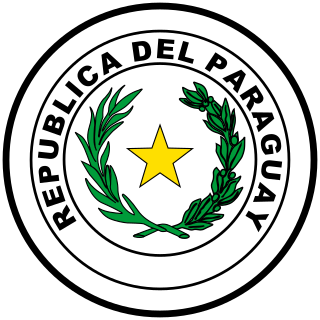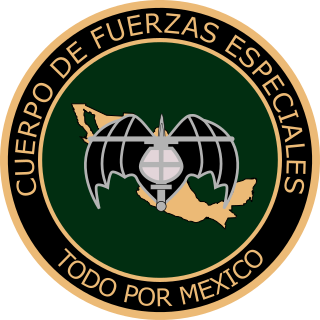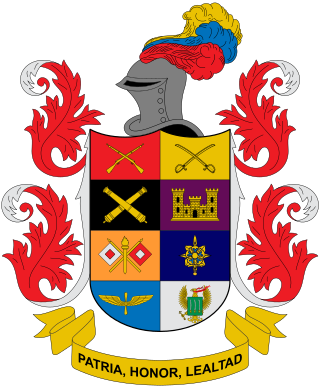This article needs additional citations for verification .(July 2024) |

In Mexico, both the army and navy have special forces groups or elite units.
This article needs additional citations for verification .(July 2024) |

In Mexico, both the army and navy have special forces groups or elite units.
The Army has Special Forces Corps unified command consisting of three Special Forces Brigades, a High Command GAFE (Grupo Aeromóvil de Fuerzas Especiales) group, a GAFE group assigned to the Airborne Brigade, 74 independent Special Forces Battalions, and 36 Amphibious Special Forces Groups. [1]
The Special Forces Brigades are formed by nine SF battalions. The First Brigade has the 1st, 2nd and 3rd SF Battalions. The Second Brigade has the 5th, 6th, 7th and 8th Battalions, while the Third Brigade has the 4th Battalions, 9th Battalions and a Rapid Intervention Force group.
The High Command GAFE is a company sized formation with no more than 150 members who are specially trained in counter-terrorist tactics. They receive orders directly from the Secretary of National Defense.
The Amphibious Special Forces Groups are trained in amphibious warfare. They give the army special capabilities on coastal and swampland operations.
The Navy has a special operations force called Fuerzas Especiales, better known as FES. Their specialties are unconventional warfare, assault, counter-terrorism, and special reconnaissance operations.
There is also another special forces unit called Batallones de Comandos Anfibios. These units carry out special tasks for the Amphibious Reaction Forces (Marines). They are known to train with their American counterparts: the Navy SEALs, at the Naval Special Warfare Center in Coronado, California.

The Armed Forces of Paraguay officially the Armed Forces of the Nation consist of the Paraguayan army, Paraguayan navy and air force.

The green beret was the official headdress of the British Commandos, a special-forces unit active during World War II. It is still worn by members of the Royal Marines after passing the Commando Course, and personnel from other units of the Royal Navy, Army and RAF who serve within UK Commando Force and who have passed the All Arms Commando Course.

The Special Forces Corps are the special forces battalions of the Mexican Army. Formerly the Special Forces Airmobile Group (Spanish: Grupo Aeromóvil de Fuerzas Especiales) or GAFE, the SF corps has six regular battalions; plus four specialized units, one of those units is the Fuerza Especial de Reaccion, the other three remain secretive for the public; the motto of the SF Corps is Todo por México.

The Brigada de Fusileros Paracaidistas, also known as Chutes, is the Mexican Army premier airborne light infantry unit similar to the 75th Ranger Regiment and the British SFSG, the unit act as support for combat operations SEDENA's EMCDN SMUs such as FEBFP or FER.
The Fuerza Especial Conjunta (Joint Special Operations Command) or FEC, previously known as Fuerza Especial de Reaccion (FER) or Fuerza Especial del Alto Mando (FEAM) (High Command Special Force) is a special unit of SEDENA, under operational control of the Joint National Defense Staff (Estado Mayor Conjunto de la Defensa Nacional). The unit's missions primarily involve counterterrorism, hostage rescue, direct action, and special reconnaissance against high-value targets.

The Marine Infantry is the naval infantry branch of the Spanish Navy responsible for conducting amphibious warfare. Fully integrated into the Spanish Navy's structure, the branch's history dates back to 1537 when Charles V, Holy Roman Emperor formed the Compañías Viejas del Mar de Nápoles, making it the oldest marine unit in existence.

The National Army of Colombia is the land warfare service branch of the Military Forces of Colombia. With over 361,420 active personnel as of 2020, it is the largest and oldest service branch in Colombia, and is the second largest army in the Americas after the United States and before Brazil.

Marines are military personnel generally trained to operate on both land and sea, with a particular focus on amphibious warfare. Historically, the main tasks undertaken by marines have included raiding ashore and the boarding of vessels during ship-to-ship combat or capture of prize ships. Marines also assisted in maintaining security, discipline, and order aboard ships. While maintaining many of their historical roles, in modern times, marines also engage in duties including rapid-response operations, humanitarian aid, disaster relief, special operations roles, and counter-terrorism operations. In most nations, marines are an integral part of that state's navy, such as the United Kingdom's Royal Marines; in some countries their marine forces can also instead be part of the land army, such as the French Troupes de Marine; or, more uncommonly, a nation’s marine forces may be an independent military branch such as the United States Marine Corps or the Ukrainian Marine Corps.

The Mexican Army is the combined land and air branch and is the largest part of the Mexican Armed Forces; it is also known as the National Defense Army.

The Ecuadorian Army is the land component of the Ecuadorian Armed Forces. Its 25,650 active soldiers are deployed in relation to its military doctrine. The contemporary Ecuadorian Army incorporates many jungle and special forces infantry units into its structure.
The Special Forces Regiment (SF) (Sinhala: විශේෂ බලකාය Visēsha Balakāya;) is a special forces unit of the Sri Lanka Army. Founded in 1986 as a combat tracker team, it was established as a regiment in 1988, and later expanded into a brigade. The unit specialises in a number of roles including counter-terrorism, direct action and covert reconnaissance. Much like the British Army Special Air Service, much of the information about the SF is highly classified due to the secrecy and sensitivity of its operations.

The Peruvian Naval Infantry (IMAP) is the only naval infantry brigade unit branch of the Peruvian Navy (MGP). Consisting of 4,000 personnel, the branch, which falls under the Pacific Operations General Command, includes an amphibious warfare brigade made up of three battalions, internal security units, jungle warfare unit made up of two battalions, two troopships, four landing craft and forty armoured personnel carriers. Since 1982, IMAP detachments have been deployed in anti-irregular military, counterinsurgency, and jungle warfare operations in the Ayacucho and Huancavelica departments of Peru.

The Mexican Armed Forces are the military forces of the United Mexican States. The Spanish crown established a standing military in colonial Mexico in the eighteenth century. After Mexican independence in 1821, the military played an important political role, with army generals serving as heads of state. Following the collapse of the Federal Army during the 1910–1920 Mexican Revolution, former revolutionary generals systematically downsized the size and power of the military.

The Naval Infantry Corps, also referred to as the Mexican Marines, are the naval infantry force of the Mexican Navy. The main task of the Infantería de Marina is to guarantee the maritime security of the country's ports and external and internal defense of the country. To accomplish these responsibilities, the corps is trained and equipped to take on any type of operations from sea, air and land. The Naval Infantry Corps is additionally responsible for Mexico's naval special operations forces (SOF), managing the Unidad de Operaciones Especiales, itself responsible for, among other units, the Fuerzas Especiales, the Mexican Navy's Tier 1 SOF unit.
{{cite web}}: CS1 maint: multiple names: authors list (link)